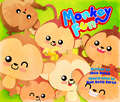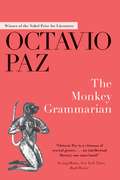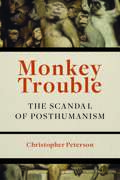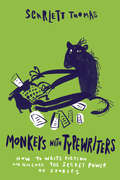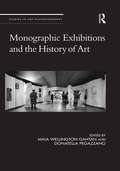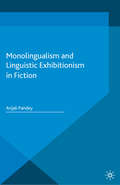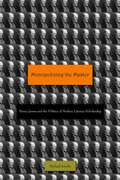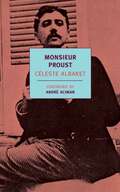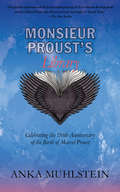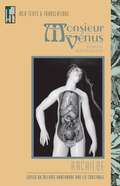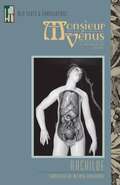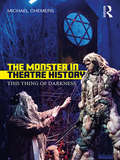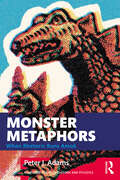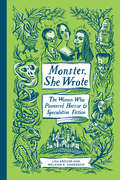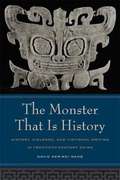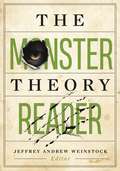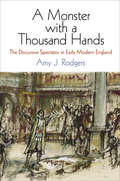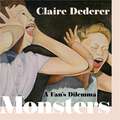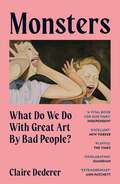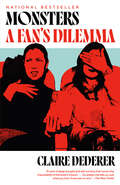- Table View
- List View
Monkey Fun! (Xist Children's Books)
by Julia DweckMonkey Fun! proves that you’re never too young to begin your learning adventure. It’s a barrel of fun and chock full of interesting monkey facts written in easy to understand rhyming verse for toddlers ages 0-4. “That’s not a monkey who’s peeling a grape. Bigger and tailless, he must be an ape.” “Monkeys who live in a family group, travel together and share with their troop.” Bold, colorful illustrations by Aida Barba Flores will capture the attention of young readers and aid in story comprehension. This is an edutaining rhyming adventure that offers fun learning resources in the back of the book including, Mrs. Dweck’s monkey facts and a monkey counting game.
The Monkey Grammarian: Conjunctions And Disjunctions - Marcel Duchamp - Appearance Stripped Bare - The Monkey Grammarian - On Poets And Others - Alternating Current (Arcade Classics Ser.)
by Octavio Paz Ilan StavansNobel Prize–winner Octavio Paz offers a dazzling mind journey to the sources of poetry. Poet, diplomat, writer, philosopher, hailed as an “intellectual literary one-man band” by the New York Times Book Review, Nobel Prize–winner Octavio Paz was a key figure in the Latin American Literary Renaissance and in world literature. In this entrancing work, part prose-poem and part rumination on the origins of language and the antic, erotic, sacred nature of poetry, Paz takes inspiration from Hanuman, the red-faced monkey chief and ninth grammarian of Hindu mythology. On a journey to the temple city of Galta in India—which Paz finds partially ruined in a leaf-filled countryside surrounded by forbidding hills—Hanuman’s mythical encounters serve as the springboard for the poet’s speculations on all manners of things, from movement and fixity to meaning and identity, the reality behind language, and the nature of nature. Images of the holy city, complete with the marauding monkeys for which it is known, constantly obtrude on his musings. Perhaps the most poetic of Paz’s prose works, The Monkey Grammarian is visual: every page is rich in images, of palaces and temples, pilgrims and sadhus, and the monkey god himself. Paz’s probing, crystalline prose makes this an unforgettable voyage of the mind.
Monkey Trouble: The Scandal of Posthumanism
by Christopher PetersonAccording to scholars of the nonhuman turn, the scandal of theory lies in its failure to decenter the human. The real scandal, however, is that we keep trying.The human has become a conspicuous blind spot for many theorists seeking to extend hospitality to animals, plants, and even insentient things. The displacement of the human is essential and urgent, yet given the humanist presumption that animals lack a number of allegedly unique human capacities, such as language, reason, and awareness of mortality, we ought to remain cautious about laying claim to any power to eradicate anthropocentrism altogether. Such a power risks becoming yet another self-accredited capacity thanks to which the human reaffirms its sovereignty through its supposed erasure.Monkey Trouble argues that the turn toward immanence in contemporary posthumanism promotes a cosmocracy that absolves one from engaging in those discriminatory decisions that condition hospitality as such. Engaging with recent theoretical developments in speculative realism and object-oriented ontology, as well as ape and parrot language studies, the book offers close readings of literary works by J.M. Coetzee, Charles Chesnutt, and Walt Whitman and films by Alfonso Cuarón and Lars von Trier.Anthropocentrism, Peterson argues, cannot be displaced through a logic of reversal that elevates immanence above transcendence, horizontality over verticality. This decentering must cultivate instead a human/nonhuman relationality that affirms the immanent transcendency spawned by our phantasmatic humanness.
Monkeys with Typewriters: How to Write Fiction and Unlock the Secret Power of Stories
by Scarlett ThomasExploring great plots from Plato to The Matrix, from Tolstoy to Toy Story, Scarlett Thomas’s new book is for writers and readers who want to unlock any narrative and create their own. Filled with creative exercises, structures, and charts, Thomas’ manual breaks down the fiction writing process and demonstrates that everyone has material to write about, whether they believe it or not. Have you ever had your heart broken, or broken someone else’s heart? Have you ever won an argument but later realized you were wrong? Have you ever tripped in public or spilled wine on someone else’s carpet? Monkeys with Typewriters is an ode to the secret power of stories, and a guide to cracking those powers open.As a bestselling author, Thomas may appear as a naturally gifted writer. However, for Thomas, fiction unlocked itself only once she recognized the importance of an author’s individual experience and one’s willingness to ask questions, not simply provide solutions. She deems the communication of one’s humanity as the key to making a piece relatable, and Thomas does nothing less in her own work. With startling and original insights into how we construct stories, Monkeys with Typewriters is a creative writing book like no other. It will show you how to not only write, but also to a finer degree, how to read.
Monographic Exhibitions and the History of Art (Studies in Art Historiography)
by Maia Wellington Gahtan Donatella PegazzanoThis edited collection traces the impact of monographic exhibitions on the discipline of art history from the first examples in the late eighteenth century through the present. Roughly falling into three genres (retrospectives of living artists, retrospectives of recently deceased artists, and monographic exhibitions of Old Masters), specialists examine examples of each genre within their social, cultural, political, and economic contexts. Exhbitions covered include Nathaniel Hone’s 1775 exhibition, the Holbein Exhibition of 1871, the Courbet retrospective of 1882, Titian's exhibition in Venice, Poussin's Louvre retrospective of 1960, and El Greco's anniversaty exhibitions of 2014.
Monolingualism and Linguistic Exhibitionism in Fiction
by Anjali PandeyHow are linguistic wars for global prominence literarily and linguistically inscribed in literature? This book focuses on the increasing presence of cosmetic multilingualism in prize-winning fiction, making a case for an emerging transparent-turn in which momentary multilingualism works in the service of long-term monolingualism.
Monopolizing the Master
by Michael AneskoHenry James defied posterity to disturb his bones: he was adamant that his legacy be based exclusively on his publications and that his private life and writings remain forever private. Despite this, almost immediately after his death in 1916 an intense struggle began among his family and his literary disciples to control his posthumous reputation, a struggle that was continued by later generations of critics and biographers. Monopolizing the Master gives a blow-by-blow account of this conflict, which aroused intense feelings of jealousy, suspicion, and proprietorship among those who claimed to be the just custodians of James's literary legacy. With an unprecedented amount of new evidence now available, Michael Anesko reveals the remarkable social, political, and sexual intrigue that inspired—and influenced—the deliberate construction of the Legend of the Master.
Monsieur Proust
by Céleste Albaret André Aciman Barbara BrayCéleste Albaret was Marcel Proust's housekeeper in his last years, when he retreated from the world to devote himself to In Search of Lost Time. She could imitate his voice to perfection, and Proust himself said to her, "You know everything about me." Her reminiscences of her employer present an intimate picture of the daily life of a great writer who was also a deeply peculiar man, while Madame Albaret herself proves to be a shrewd and engaging companion.
Monsieur Proust's Library
by Anka MuhlsteinReading was so important to Marcel Proust that it sometimes seems he was unable to create a personage without a book in hand. Everybody in his work reads: servants and masters, children and parents, artists and physicians. The more sophisticated characters find it natural to speak in quotations. Proust made literary taste a means of defining personalities and gave literature an actual role to play in his novels. In this wonderfully entertaining book, scholar and biographer Anka Muhlstein, the author of Balzac's Omelette, draws out these themes in Proust's work and life, thus providing not only a friendly introduction to the momentous In Search of Lost Time, but also exciting highlights of some of the finest work in French literature.
Monsieur Vénus: Roman matérialiste (Texts and Translations #15)
by RachildeWhen the rich and well-connected Raoule de Vénérande becomes enamored of Jacques Silvert, a poor young man who makes artificial flowers for a living, she turns him into her mistress and eventually into her wife. Raoule's suitor, a cigar-smoking former hussar officer, becomes an accomplice in the complications that ensue.
Monsieur Vénus: A Materialist Novel (Texts and Translations #15)
by RachildeWhen the rich and well-connected Raoule de Vénérande becomes enamored of Jacques Silvert, a poor young man who makes artificial flowers for a living, she turns him into her mistress and eventually into her wife. Raoule's suitor, a cigar-smoking former hussar officer, becomes an accomplice in the complications that ensue.
Monster and the Magic Umbrella
by Ellen Blance Ann Mariah CookWhat will Monster do with his magic umbrella?
The Monster in Theatre History: This Thing of Darkness
by Michael ChemersMonsters are fragmentary, uncertain, frightening creatures. What happens when they enter the realm of the theatre? The Monster in Theatre History explores the cultural genealogies of monsters as they appear in the recorded history of Western theatre. From the Ancient Greeks to the most cutting-edge new media, Michael Chemers focuses on a series of ‘key’ monsters, including Frankenstein’s creature, werewolves, ghosts, and vampires, to reconsider what monsters in performance might mean to those who witness them. This volume builds a clear methodology for engaging with theatrical monsters of all kinds, providing a much-needed guidebook to this fascinating hinterland.
Monster Metaphors: When Rhetoric Runs Amok (Routledge Studies in Rhetoric and Stylistics)
by Peter J. AdamsThis book explores ways in which common metaphors can play a detrimental role in everyday life; how they can grow in outsized importance to dominate their respective terrains and push out alternative perspectives; and how forms of resistance might act to contain their dominance. The volume begins by unpacking the dynamics of metaphors, their power and influence and the ways in which they are bolstered by other rhetorical devices. Adams draws on four case studies to illustrate their destructive impact when they eclipse other points of view—the metaphor of mental illness; the metaphor of free-flowing markets; the metaphor of the mind as a mirror and the metaphor of men as naturally superior. Taken together, these examples prompt further reflection on the beneficiaries of these "monster metaphors" and how they promote such metaphors to serve their own interests but also on ways forward for challenging their dominance, strategies for preventing their rise and ways of creating space for alternatives. This book will be of interest to scholars interested in the study of metaphor, across such fields as linguistics, rhetoric and media studies.
Monster, She Wrote: The Women Who Pioneered Horror and Speculative Fiction
by Melanie R. Anderson Lisa KrögerMeet the women writers who defied convention to craft some of literature’s strangest tales, from Frankenstein to The Haunting of Hill House and beyond. Frankenstein was just the beginning: horror stories and other weird fiction wouldn’t exist without the women who created it. From Gothic ghost stories to psychological horror to science fiction, women have been primary architects of speculative literature of all sorts. And their own life stories are as intriguing as their fiction. Everyone knows about Mary Shelley, creator of Frankenstein, who was rumored to keep her late husband’s heart in her desk drawer. But have you heard of Margaret “Mad Madge” Cavendish, who wrote a science-fiction epic 150 years earlier (and liked to wear topless gowns to the theater)? If you know the astounding work of Shirley Jackson, whose novel The Haunting of Hill House was reinvented as a Netflix series, then try the psychological hauntings of Violet Paget, who was openly involved in long-term romantic relationships with women in the Victorian era. You’ll meet celebrated icons (Ann Radcliffe, V. C. Andrews), forgotten wordsmiths (Eli Colter, Ruby Jean Jensen), and today’s vanguard (Helen Oyeyemi). Curated reading lists point you to their most spine-chilling tales.Part biography, part reader’s guide, the engaging write-ups and detailed reading lists will introduce you to more than a hundred authors and over two hundred of their mysterious and spooky novels, novellas, and stories.
The Monster That Is History: History, Violence, and Fictional Writing in Twentieth-century China
by David WangIn ancient China a monster called Taowu was known for both its vicious nature and its power to see the past and the future. Over the centuries Taowu underwent many incarnations until it became identifiable with history itself. Since the seventeenth century, fictive accounts of history have accommodated themselves to the monstrous nature of Taowu. Moving effortlessly across the entire twentieth-century literary landscape, David Der-wei Wang delineates the many meanings of Chinese violence and its literary manifestations. Taking into account the campaigns of violence and brutality that have rocked generations of Chinese--often in the name of enlightenment, rationality, and utopian plenitude--this book places its arguments along two related axes: history and representation, modernity and monstrosity. Wang considers modern Chinese history as a complex of geopolitical, ethnic, gendered, and personal articulations of bygone and ongoing events. His discussion ranges from the politics of decapitation to the poetics of suicide, and from the typology of hunger and starvation to the technology of crime and punishment.
Monster Theory: Reading Culture
by Jeffrey Jerome CohenWe live in a time of monsters. Monsters provide a key to understanding the culture that spawned them. So argue the essays in this wide-ranging and fascinating collection that asks the question, What happens when critical theorists take the study of monsters seriously as a means of examining our culture? In viewing the monstrous body as a metaphor for the cultural body, the contributors to Monster Theory consider beasts, demons, freaks, and fiends as symbolic expressions of cultural unease that pervade a society and shape its collective behavior. Through a historical sampling of monsters, these essays argue that our fascination for the monstrous testifies to our continued desire to explore difference and prohibition.Contributors: Mary Baine Campbell, Brandeis U; David L. Clark, McMaster U; Frank Grady, U of Missouri, St. Louis; David A. Hedrich Hirsch, U of Illinois; Lawrence D. Kritzman, Dartmouth College; Kathleen Perry Long, Cornell U; Stephen Pender; Allison Pingree, Harvard U; Anne Lake Prescott, Barnard College; John O'Neill, York U; William Sayers, George Washington U; Michael Uebel, U of Virginia; Ruth Waterhouse.
The Monster Theory Reader
by Jeffrey Andrew WeinstockA collection of scholarship on monsters and their meaning—across genres, disciplines, methodologies, and time—from foundational texts to the most recent contributions Zombies and vampires, banshees and basilisks, demons and wendigos, goblins, gorgons, golems, and ghosts. From the mythical monstrous races of the ancient world to the murderous cyborgs of our day, monsters have haunted the human imagination, giving shape to the fears and desires of their time. And as long as there have been monsters, there have been attempts to make sense of them, to explain where they come from and what they mean. This book collects the best of what contemporary scholars have to say on the subject, in the process creating a map of the monstrous across the vast and complex terrain of the human psyche.Editor Jeffrey Andrew Weinstock prepares the way with a genealogy of monster theory, traveling from the earliest explanations of monsters through psychoanalysis, poststructuralism, and cultural studies, to the development of monster theory per se—and including Jeffrey Jerome Cohen&’s foundational essay &“Monster Theory (Seven Theses),&” reproduced here in its entirety. There follow sections devoted to the terminology and concepts used in talking about monstrosity; the relevance of race, religion, gender, class, sexuality, and physical appearance; the application of monster theory to contemporary cultural concerns such as ecology, religion, and terrorism; and finally the possibilities monsters present for envisioning a different future. Including the most interesting and important proponents of monster theory and its progenitors, from Sigmund Freud to Julia Kristeva to J. Halberstam, Donna Haraway, Barbara Creed, and Stephen T. Asma—as well as harder-to-find contributions such as Robin Wood&’s and Masahiro Mori&’s—this is the most extensive and comprehensive collection of scholarship on monsters and monstrosity across disciplines and methods ever to be assembled and will serve as an invaluable resource for students of the uncanny in all its guises.Contributors: Stephen T. Asma, Columbia College Chicago; Timothy K. Beal, Case Western Reserve U; Harry Benshoff, U of North Texas; Bettina Bildhauer, U of St. Andrews; Noel Carroll, The Graduate Center, CUNY; Jeffrey Jerome Cohen, Arizona State U; Barbara Creed, U of Melbourne; Michael Dylan Foster, UC Davis; Sigmund Freud; Elizabeth Grosz, Duke U; J. Halberstam, Columbia U; Donna Haraway, UC Santa Cruz; Julia Kristeva, Paris Diderot U; Anthony Lioi, The Julliard School; Patricia MacCormack, Anglia Ruskin U; Masahiro Mori; Annalee Newitz; Jasbir K. Puar, Rutgers U; Amit A. Rai, Queen Mary U of London; Margrit Shildrick, Stockholm U; Jon Stratton, U of South Australia; Erin Suzuki, UC San Diego; Robin Wood, York U; Alexa Wright, U of Westminster.
A Monster with a Thousand Hands: The Discursive Spectator in Early Modern England
by Amy J. RodgersA Monster with a Thousand Hands makes visible a figure that has been largely overlooked in early modern scholarship on theater and audiences: the discursive spectator, an entity distinct from the actual bodies attending early modern English playhouses. Amy J. Rodgers demonstrates how the English commercial theater's rapid development and prosperity altered the lexicon for describing theatergoers and the processes of engagement that the theater was believed to cultivate. In turn, these changes influenced and produced a cultural projection—the spectator—a figure generated by social practices rather than a faithful recording of those who attended the theater. The early modern discursive spectator did not merely develop alongside the phenomenological one, but played as significant a role in shaping early modern viewers and viewing practices as did changes to staging technologies, exhibition practices, and generic experimentation.While audience and film studies have theorized the spectator, these fields tend to focus on the role of twentieth-century media (film, television, and the computer) in producing mass-culture viewers. Such emphases lead to a misapprehension that the discursive spectator is modernity's creature. Fearing anachronism, early modern scholars have preferred demographic studies of audiences to theoretical engagements with the "effects" of spectatorship. While demographic work provides an invaluable snapshot, it cannot account for the ways that the spectator is as much an idea as a material presence. And, while a few studies pursue the dynamics that existed among author, text, and audience using critical tools sharpened by film studies, they tend to obscure how early modern culture understood the spectator. Rather than relying exclusively on historical or theoretical methodologies, A Monster with a Thousand Hands reframes spectatorship as a subject of inquiry shaped both by changes in entertainment technologies and the interaction of groups and individuals with different forms of cultural production.
The Monstered Self: Narratives of Death and Performance in Latin American Fiction
by Eduardo GonzálezViewing stories and novels from an ethnographic perspective, Eduardo González here explores the relationship between myth, ritual, and death in writings by Borges, Vargas Llosa, Cortázar, and Roa Bastos. He then weaves this analysis into a larger cultural fabric composed of the works of Chaucer, Shakespeare, Joyce, Benjamin, H. G. Wells, Kafka, Poe, and others.What interests González is the signature of authorial selfhood in narrative and performance, which he finds willfully and temptingly disfigured in the works he examines: horrific and erotic, subservient and tyrannical, charismatic and repellent. Searching out the personal image and plot, González uncovers two fundamental types of narrative: one that strips character of moral choice; and another in which characters' choices deprive them of personal autonomy and hold them in ritual bondage to a group. Thus The Monstered Self becomes a study of the conflict between individual autonomy and the stereotypes of solidarity.Written in a characteristically allusive, elliptical style, and drawing on psychoanalysis, religion, mythology, and comparative literature, The Monstered Self is in itself a remarkable performance, one that will engage readers in anthropology, psychology, and cultural history as well as those specifically interested in Latin American narrative.
Monsters
by L. Andrew Cooper Brandy Ball BlakeThe Fountainhead Press V Series is a new collection of single-topic readers that take a unique look at some of today's most pressing issues. Designed to give writing students a more nuanced introduction to public discourse--on the environment, on food, and on digital life, to name a few of the topics--the books feature writing, research, and invention prompts that can be adapted to nearly any kind of college writing class.
Monsters: A Fan’s Dilemma
by Claire DedererA passionate, provocative and blisteringly smart interrogation of how we experience art in the age of #MeToo, and whether we can separate an artist's work from their biography.What do we do with the art of monstrous men? Can we love the work of Roman Polanski and Michael Jackson, Hemingway and Picasso? Should we love it? Does genius deserve special dispensation? Is history an excuse? What makes women artists monstrous? And what should we do with beauty, and with our unruly feelings about it?Claire Dederer explores these questions and our relationships with the artists whose behaviour disrupts our ability to apprehend the work on its own terms. She interrogates her own responses and her own behaviour, and she pushes the fan, and the listener, to do the same. Morally wise, deeply considered and sharply written, Monsters gets to the heart of one of our most pressing conversations.(P) 2023 Penguin Audio
Monsters: A Fan’s Dilemma
by Claire Dederer'An exhilarating, shape-shifting exploration of the perilous boundaries between art and life' JENNY OFFILL'An incredible book, the best work of criticism I have read in a very long time' NICK HORNBY'Wise and bold and full of the kind of gravitas that might even rub off' LISA TADDEOA passionate, provocative and blisteringly smart interrogation of how we experience art in the age of #MeToo, and whether we can separate an artist's work from their biography.What do we do with the art of monstrous men? Can we love the work of Roman Polanski and Michael Jackson, Hemingway and Picasso? Should we love it? Does genius deserve special dispensation? What makes women artists monstrous? And what should we do with beauty, and with our unruly feelings about it?Claire Dederer explores these questions and our relationships with the artists whose behaviour disrupts our ability to understand the work on its own terms. She interrogates her own responses and behaviour, and she pushes the fan, and the reader, to do the same. Morally wise, deeply considered and sharply written, Monsters gets to the heart of one of our most pressing conversations.'A blisteringly erudite and entertaining read . . . It's a book that deserves to be widely read and will provoke many conversations' NATHAN FILER'Fascinating . . . Dederer poses so many topical questions, plays with so many pertinent ideas, that I'm still thinking about this book long after I finished it' CLAIRE FULLER
Monsters: A Fan's Dilemma
by Claire DedererA NEW YORK TIMES NOTABLE BOOK • NATIONAL BESTSELLER • A timely, passionate, provocative, blisteringly smart interrogation of how we make and experience art in the age of cancel culture, and of the link between genius and monstrosity. Can we love the work of controversial classic and contemporary artists but dislike the artist?"A lively, personal exploration of how one might think about the art of those who do bad things" —Vanity Fair • "[Dederer] breaks new ground, making a complex cultural conversation feel brand new." —Ada Calhoun, author of Also a Poet From the author of the New York Times best seller Poser and the acclaimed memoir Love and Trouble, Monsters is &“part memoir, part treatise, and all treat&” (The New York Times). This unflinching, deeply personal book expands on Claire Dederer&’s instantly viral Paris Review essay, "What Do We Do with the Art of Monstrous Men?" Can we love the work of artists such as Hemingway, Sylvia Plath, Miles Davis, Polanski, or Picasso? Should we? Dederer explores the audience's relationship with artists from Michael Jackson to Virginia Woolf, asking: How do we balance our undeniable sense of moral outrage with our equally undeniable love of the work? Is male monstrosity the same as female monstrosity? And if an artist is also a mother, does one identity inexorably, and fatally, interrupt the other? In a more troubling vein, she wonders if an artist needs to be a monster in order to create something great. Does genius deserve special dispensation? Does art have a mandate to depict the darker elements of the psyche? And what happens if the artist stares too long into the abyss? Highly topical, morally wise, honest to the core, Monsters is certain to incite a conversation about whether and how we can separate artists from their art.&“Monsters leaves us with Dederer&’s passionate commitment to the artists whose work most matters to her, and a framework to address these questions about the artists who matter most to us." —The Washington PostA Best Book of the Year: The New York Times, NPR, The Washington Post, The New Yorker, Vulture, Elle, Esquire, Kirkus
